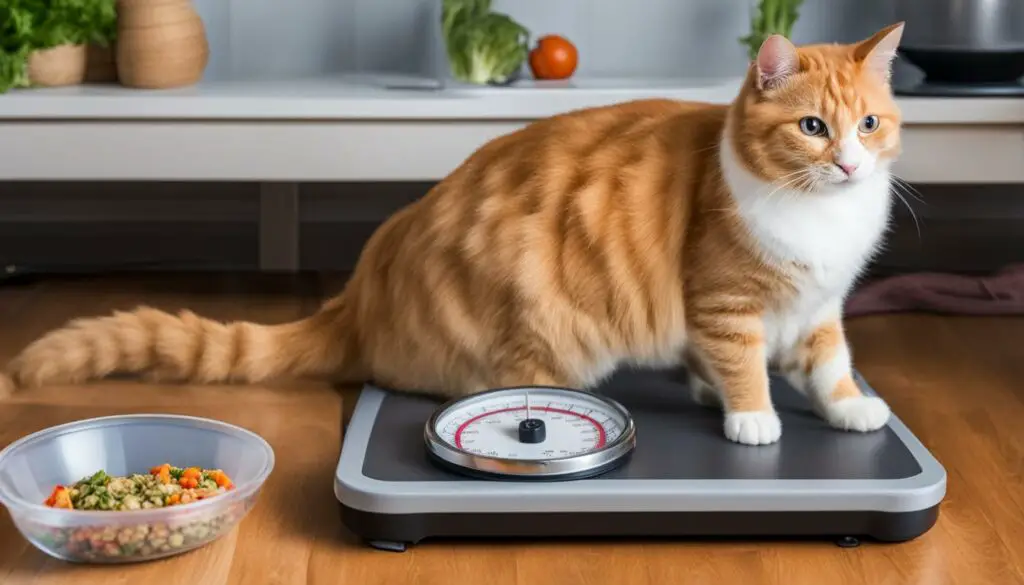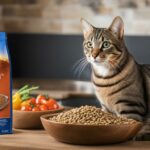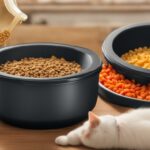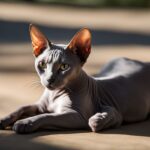Hello, fellow cat lovers! Are you worried about your furry friend’s weight? You’re not alone. According to the Association for Pet Obesity Prevention, nearly 60 percent of cats in the United States are overweight. But fret not! With some expert tips and tricks, you can help your cat shed those extra pounds and improve their overall health and well-being.
First things first, it’s essential to assess your cat’s body condition and consult with a veterinarian to determine their ideal weight. From there, you can create a personalized weight loss plan that includes feeding guidelines and strategies to increase exercise.
Key Takeaways:
- Assess your cat’s body condition and consult with a veterinarian to determine their ideal weight.
- Calculate your cat’s calorie intake for weight loss and adjust as needed.
- Select a high-quality cat food specifically designed for weight loss.
- Establish a feeding routine and consider using programmable feeders.
- Incorporate regular exercise sessions and provide climbing surfaces and engaging toys.
The Importance of Weight Loss for Cats
Weight loss is crucial for cats to ensure their overall health and well-being. Carrying excess weight can have detrimental effects on their quality of life and may lead to various health issues. As responsible pet owners, it is our duty to prioritize weight management for our furry friends.
Overweight cats are at a higher risk for heart disease, diabetes, osteoarthritis, joint injuries, high blood pressure, and certain forms of cancer. These conditions can significantly impact their lifespan and quality of life. By focusing on cat weight loss, we can reduce the risk of these health problems and improve their overall prognosis.
The key to successful cat weight management is a combination of proper nutrition and regular exercise. By providing a balanced and controlled diet, we can ensure that our cats receive the necessary nutrients without the excess calories that contribute to weight gain. Additionally, engaging in regular physical activity helps burn calories and maintain muscle tone, helping cats achieve and maintain a healthy weight.
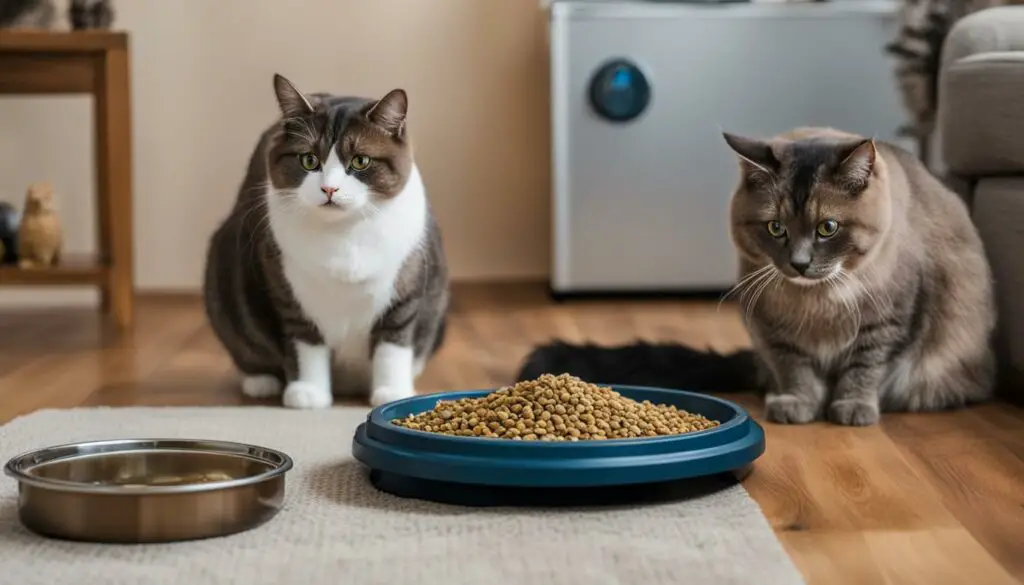
Cat Obesity Prevention
To prevent obesity in cats, it’s essential to monitor their weight and body condition regularly. Consult with your veterinarian to determine your cat’s ideal weight and develop a weight loss plan tailored to their needs. Focus on gradual and sustainable weight loss to ensure their health and well-being throughout the process.
Remember, weight loss should always be approached under the guidance of a veterinarian to ensure the safety and effectiveness of the process. Each cat is unique, and their weight loss journey may require individual adjustments and considerations.
| Benefits of Weight Loss for Cats | Risks of Cat Obesity |
|---|---|
| – Improved cardiovascular health | – Higher risk of heart disease |
| – Reduced risk of diabetes | – Increased likelihood of diabetes |
| – Better joint mobility | – Higher risk of arthritis |
| – Increased energy and playfulness | – Reduced activity and lethargy |
By understanding the importance of weight loss for cats and taking proactive steps towards cat obesity prevention, we can ensure our feline companions live long, healthy, and happy lives.
Determining If Your Cat Needs to Lose Weight
When it comes to helping your cat lose weight, the first step is to determine if they actually need to shed a few pounds. Instead of relying solely on the number on the scale, it’s important to assess your cat’s body condition. Look out for signs such as a lack of waist definition, difficulty feeling their ribs, and a droopy belly. These can indicate that your cat is carrying excess weight.
If your cat’s body shape suggests that they are overweight, it’s important to consult with a veterinarian to confirm and determine their ideal weight. A veterinarian will be able to assess your cat’s overall health and body composition, taking into account factors such as breed, age, and activity level. They can provide expert guidance on whether your cat needs to lose weight and create a tailored weight loss plan.
Assessing Your Cat’s Body Condition Score
One way to determine if your cat is at a healthy weight is by using a body condition score (BCS) chart. This tool helps you visually assess your cat’s body shape and condition. It typically assigns a score from 1 to 9, with 1 being extremely underweight and 9 being extremely obese. A score of 5 is considered ideal, with a visible waistline and easily felt ribs. Your veterinarian can help you interpret the BCS chart and guide you in determining your cat’s current weight status.
| Body Condition Score | Description |
|---|---|
| 1 | Emaciated – No muscle or fat visible, protruding bones |
| 2 | Underweight – No body fat, bones easily felt |
| 3 | Thin – Some body fat, ribs easily felt |
| 4 | Ideal – Visible waistline, ribs easily felt |
| 5 | Overweight – Slight loss of waistline, ribs slightly felt |
| 6 | Heavy – No waistline, ribs not easily felt |
| 7 | Obese – Pronounced abdomen, no discernible waistline |
| 8 | Severely Obese – Round and distended abdomen |
| 9 | Extremely Obese – Abdomen touches the ground |
By assessing your cat’s body condition and consulting with a veterinarian, you can determine if weight loss is necessary and create a plan to help your furry friend achieve a healthier weight.
Calculating Calories for Cat Weight Loss
When it comes to helping your cat lose weight, calculating their calorie intake is an essential step. By determining the number of calories your cat should consume for weight loss, you can create a customized feeding plan that supports their goals. Here’s how you can calculate calories for your cat’s weight loss journey.
To begin, it’s important to know your cat’s current caloric intake. This can be determined by checking the label on their current food packaging or consulting with your veterinarian. Once you have this information, you can proceed to reduce the amount by 20 percent. Alternatively, you can use a cat weight loss formula provided by your veterinarian to determine the appropriate calorie intake for your cat.
When starting a weight loss program for your cat, it’s important to aim for a gradual weight loss rather than rapid results. Rapid weight loss can lead to a condition called fatty liver disease. It is recommended to aim for a weekly weight loss of half to two percent of your cat’s body weight. Monitoring your cat’s progress is crucial, allowing you to adjust their calorie intake as needed to ensure a safe and healthy weight loss journey.
| Calorie Calculation | Weekly Weight Loss Goal |
|---|---|
| 20% reduction from current caloric intake | 0.5% to 2% of cat’s body weight |
Remember, every cat is unique, and their weight loss journey may require adjustments along the way. Consulting with your veterinarian is essential to ensure that your cat’s specific needs are met throughout the process. By monitoring their progress and making necessary changes, you can help your cat achieve a healthy weight and improve their overall well-being.
Choosing the Right Food for Weight Loss
When it comes to helping your cat lose weight, selecting the right food is essential. Opting for a high-quality cat food specifically designed for weight loss can provide the necessary nutrients while promoting healthy weight loss. Look for formulas that are low in calories and fat, but still packed with essential vitamins and minerals. These diets are specially formulated to help your cat feel satisfied while reducing calorie intake.
Gradually transitioning your cat to the new weight loss food is important to avoid digestive issues. Over a period of one to two weeks, mix small amounts of the new food with your cat’s current food, gradually increasing the ratio of the new food. This slow transition will help your cat adjust to the new taste and texture without causing any upsets. Additionally, consider using puzzle feeders or feeding toys to make mealtime more engaging, allowing your cat to regulate portion sizes and slow down their eating.
Table:
| Benefits of Choosing the Right Food for Weight Loss | Features |
|---|---|
| Promotes healthy weight loss | Low in calories and fat |
| Provides essential nutrients | High-quality ingredients |
| Helps keep your cat satisfied | Formulated for weight management |
| Aids in portion control | Engaging feeding options |

Feeding Strategies for Weight Loss
When it comes to helping an overweight cat lose weight, establishing a feeding routine and implementing portion control are crucial. By following these feeding guidelines for overweight cats, you can ensure that your cat is receiving the right amount of food to support their weight loss journey.
Portion Control
One of the key strategies for weight loss in cats is portion control. Rather than leaving food out all day for your cat to graze on, it’s important to provide measured portions at specific meal times. This helps regulate calorie intake and prevents overeating. Consult with your veterinarian to determine the appropriate portion size for your cat based on their ideal weight and calorie requirements.
Dividing Meals
Instead of feeding your cat one or two large meals a day, consider dividing their daily calorie intake into several smaller meals. This can help prevent hunger pangs and keep your cat satisfied throughout the day. Aim for at least three to four meals per day, spaced out at regular intervals. If you have multiple cats, it’s important to separate their feeding bowls to ensure that each cat eats their own portion.
Programmable Feeders
If you’re unable to be present for your cat’s meal times, programmable feeders can be a great solution. These devices allow you to set specific times for meals, ensuring that your cat receives their food on a consistent schedule. Programmable feeders also help prevent overfeeding and can be especially beneficial for weight management in multi-cat households.
| Feeding Strategy | Benefits |
|---|---|
| Portion Control | Regulates calorie intake and prevents overeating. |
| Dividing Meals | Prevents hunger pangs and keeps the cat satisfied throughout the day. |
| Programmable Feeders | Ensures consistent meal times and prevents overfeeding. |
Implementing these feeding strategies alongside a balanced weight loss diet and regular exercise can contribute to a successful weight loss journey for your cat. Remember to monitor your cat’s progress, make adjustments as needed, and consult with your veterinarian for personalized guidance.
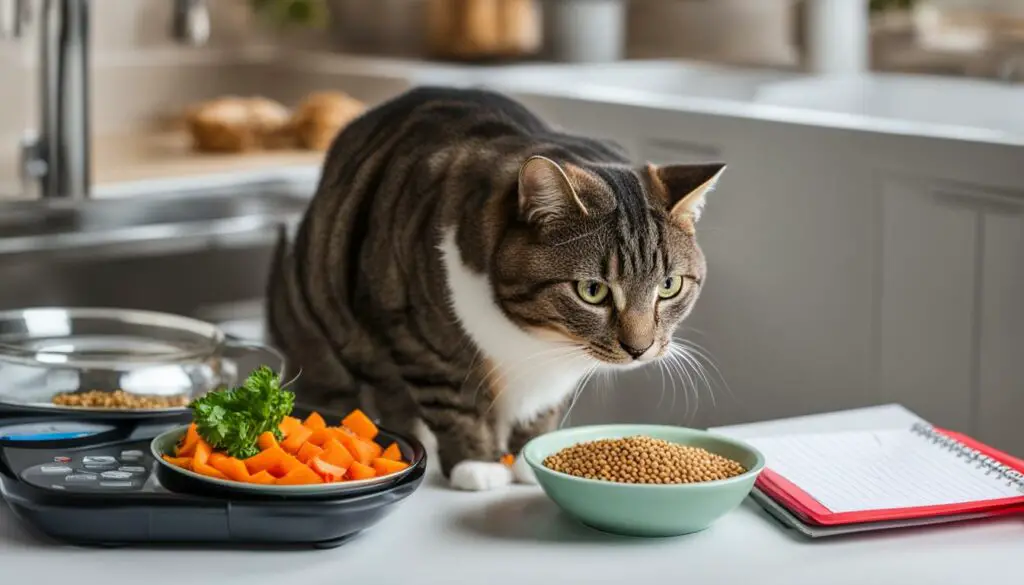
Encouraging Exercise for Weight Loss
Regular physical activity is essential for cats to lose weight and maintain a healthy lifestyle. By engaging in exercise routines and increasing cat activity, you can help your feline friend shed those extra pounds and improve their overall well-being.
One effective way to encourage exercise is through interactive play sessions. Use toys like feather wands or laser pointers to engage your cat in short bursts of activity. Aim for five to ten minutes of playtime at each session, gradually increasing the duration as your cat becomes more fit.
Providing climbing surfaces, such as cat trees or shelves, can also help stimulate your cat’s natural instinct to climb and explore. Rotate toys and introduce new ones regularly to keep them engaged and active throughout the day.
| Exercise Tips for Cats | Benefits |
|---|---|
| Interactive play sessions | Increases physical activity |
| Providing climbing surfaces | Stimulates natural instincts |
| Using puzzle feeders | Combines mental stimulation and exercise |
| Creating obstacle courses | Promotes agility and coordination |
In addition to playtime, consider using puzzle feeders or feeding toys to make mealtime more engaging for your cat. These interactive feeding options combine mental stimulation with physical activity, encouraging your cat to work for their food and helping them burn calories.
Remember to always consult with your veterinarian before starting any exercise routine or making significant changes to your cat’s activity level. They can provide personalized guidance based on your cat’s unique needs and health considerations.
Treating vs. Non-Food Rewards
When it comes to rewarding our cats, it’s important to consider alternatives to food treats. While treats can be enjoyable for our feline friends, they can also contribute to weight gain and undermine their weight loss efforts. To keep our cats motivated and reinforce positive behavior, we can explore non-food rewards that provide both mental and physical stimulation.
Rewarding Playtime
One great alternative to food treats is to reward our cats with extra playtime. Cats are natural hunters, and interactive play sessions can help satisfy their instinctual needs while also burning calories. Grab a feather wand or laser pointer and engage in short bursts of play, making it a fun and enjoyable experience for both you and your cat. By incorporating play as a reward, you can encourage your cat to stay active and make weight loss a playful journey.
Bonding Through Cuddles
Cats thrive on affection and the bond they share with their human companions. Instead of offering food treats, spend quality time cuddling and petting your cat. This not only strengthens your connection but also provides emotional support and reassurance. Making time for regular cuddles can help reduce stress and anxiety, ensuring your cat is in a positive state of mind while working towards their weight loss goals.
“Rewarding our cats with playtime and cuddles instead of food treats not only helps with weight loss but also strengthens the bond between pet and owner.”
– Dr. Emily Johnson, Feline Nutrition Specialist
By replacing food treats with alternative rewards like playtime and cuddles, we can ensure that our cats are receiving positive reinforcement without the added calories. It’s important, however, to avoid making drastic changes to your cat’s diet, as this can lead to refusal or stress. Instead, gradually introduce new foods and flavors to ensure acceptance and keep your cat engaged throughout their weight loss journey.
| Food Treats | Non-Food Rewards |
|---|---|
| High in calories | Low in calories |
| Contribute to weight gain | Promote mental and physical stimulation |
| Can undermine weight loss efforts | Encourage play and bonding |
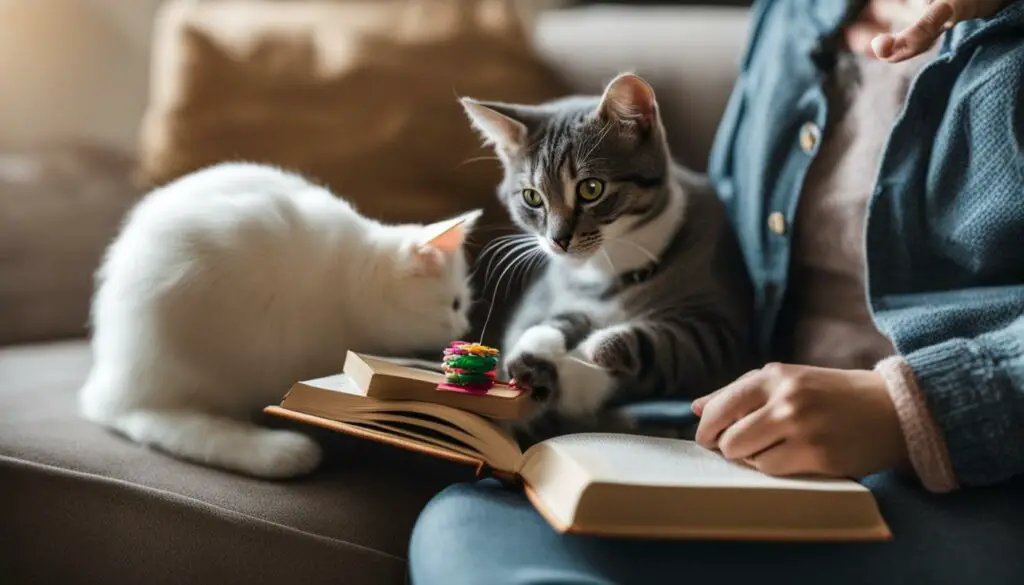
Special Weight Loss Diets for Cats
When it comes to helping your cat shed those extra pounds, special weight loss diets can be an effective tool. These veterinary-formulated diets are specifically designed to provide balanced nutrition while promoting weight loss. They often contain a carefully calculated balance of nutrients, such as high protein and low carbohydrates or high fiber content, to help your cat feel full while reducing calorie intake.
There are several options available in the market, each with its own unique formula and approach to weight management. Some popular brands include Hill’s Prescription Diet, Royal Canin Veterinary Diet, and Purina Pro Plan Veterinary Diets. These diets are available in both dry and wet formulations, allowing you to choose the one that suits your cat’s preferences and dietary needs.
It’s important to note that weight loss diets should be used under the guidance of a veterinarian. They will assess your cat’s individual needs and recommend the most suitable diet for your furry friend. The veterinarian may also provide instructions on feeding guidelines and portion control to ensure your cat’s weight loss journey is safe and effective.
| Diet Brand | Main Features |
|---|---|
| Hill’s Prescription Diet | – High protein, low carbohydrate formula – Helps maintain lean muscle mass – Supports healthy weight loss |
| Royal Canin Veterinary Diet | – Balanced nutrition with controlled calorie content – Helps reduce fat accumulation – Supports weight loss and maintenance |
| Purina Pro Plan Veterinary Diets | – Offers a variety of weight loss formulas – Provides essential nutrients and vitamins – Helps cats feel satisfied while losing weight |
Consulting with your veterinarian is crucial before making any changes to your cat’s diet. They will help determine the best weight loss diet for your cat’s specific needs and monitor their progress throughout the weight loss journey. Remember, patience and consistency are key to achieving and maintaining a healthy weight for your beloved feline companion.
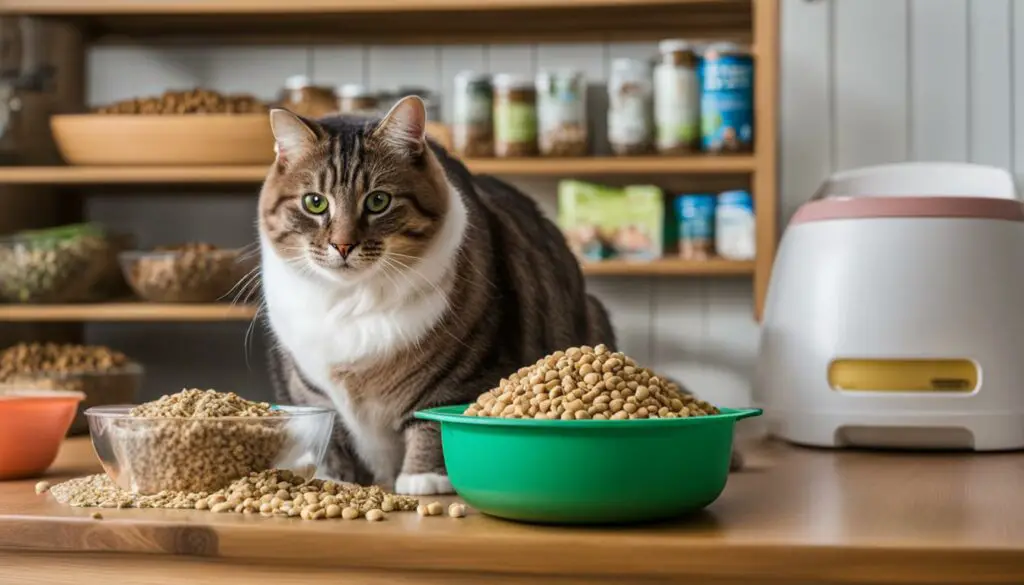
Transitioning to a New Diet
When it comes to helping your cat lose weight, transitioning to a new diet is a crucial step. Introducing a weight loss food gradually is important to ensure your cat’s acceptance and prevent any digestive issues. Follow these tips to make the transition smooth and successful:
Start Slowly
Begin by offering small amounts of the new weight loss food alongside your cat’s current food. This will allow them to become familiar with the new smell and taste without overwhelming their digestive system. Gradually increase the ratio of the new food to the old food over the course of three weeks.
Enhance Palatability
If your cat seems hesitant about the new diet, you can enhance the palatability by adding flavorings or warming the food slightly. This can help entice your cat to try the new food and make the transition more enjoyable for them.
Monitor Acceptance
Throughout the transition, closely monitor your cat’s acceptance of the new diet. Pay attention to their appetite, stools, and overall behavior. If you notice any concerns or changes in their health, consult with your veterinarian for guidance.
Remember, transitioning to a new diet is a gradual process that requires patience and monitoring. By following these tips, you can help your cat adjust to their weight loss food and support them in their journey towards a healthier weight.
| Transitioning to a New Diet | Tips |
|---|---|
| Start Slowly | Offer small amounts of the new food alongside the current food |
| Enhance Palatability | Add flavorings or warm the food slightly |
| Monitor Acceptance | Closely observe your cat’s appetite, stools, and behavior |
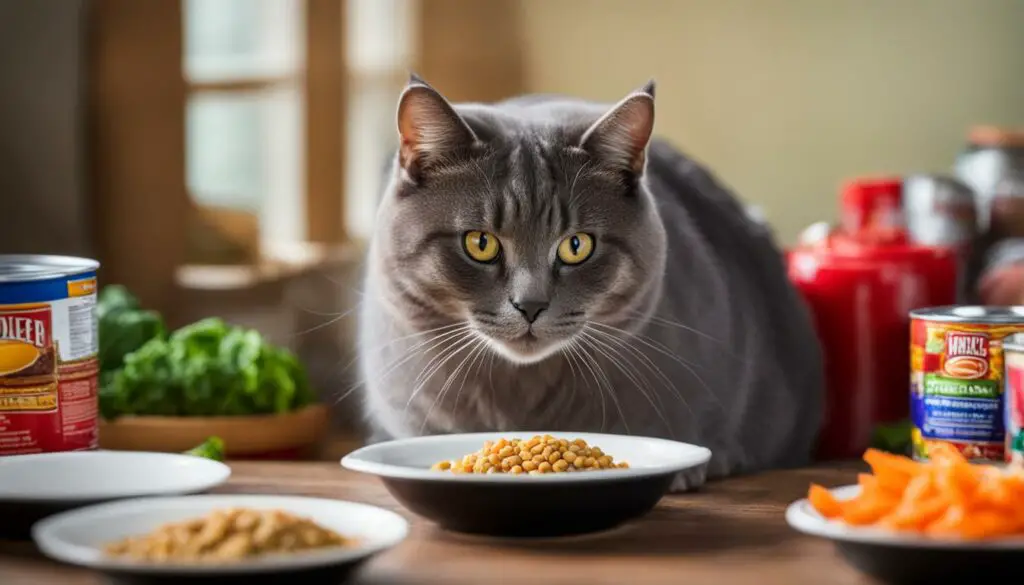
Monitoring Weight Loss Progress
Tracking your cat’s weight loss progress is an essential part of ensuring their success on their weight loss journey. Regular weigh-ins and record-keeping can help you monitor their progress and make necessary adjustments to their diet and exercise plan. Weigh your cat every one to two weeks using a scale specifically designed for pets. Keep a diary or use a digital tracker to record their weight for easy reference. Celebrate even small weight losses, as every bit of progress is significant for your cat’s health and well-being.
When monitoring your cat’s weight loss, it’s important to note that the rate of weight loss may vary. Aim for a gradual weight loss of half to two percent of your cat’s body weight per week. Rapid weight loss can be detrimental to their health and may increase the risk of developing fatty liver disease. If you have concerns about your cat’s weight loss progress, consult with your veterinarian for guidance and reassessment of their weight loss plan.
In addition to weighing your cat, pay attention to other signs of progress, such as improved energy levels and mobility. If your cat is engaging in more physical activity and showing a greater interest in playtime, it’s a positive indication that their weight loss efforts are paying off. Remember, weight loss is not just about the numbers on the scale but also about improving their overall well-being.
By diligently monitoring your cat’s weight loss progress, you can make informed decisions about their calorie intake and exercise routine. Keep in mind that each cat is unique, and their weight loss journey may require adjustments along the way. Regular communication with your veterinarian will ensure that you are on the right track and give your cat the best chance for a healthier, happier life.
![]()
Frequently Asked Questions
- How often should I weigh my cat during their weight loss journey?
- What should I do if my cat’s weight loss progress seems slow?
- What are some other signs of progress besides weight loss?
- Why is it important to consult with a veterinarian during the weight loss process?
Managing Hunger and Adjusting the Diet
During the weight loss journey, it’s common for cats to experience hunger as their calorie intake is reduced. However, there are strategies you can employ to manage your cat’s hunger and ensure their well-being. One approach is to provide distractions, such as engaging toys and affectionate playtime, to keep your cat mentally stimulated and occupied. This can help shift their focus away from food and alleviate feelings of hunger.
Another helpful tactic is to add water to your cat’s food. This not only increases their sense of satiety but also promotes good kidney and bladder health. The additional moisture can help your cat feel fuller while reducing their overall calorie intake. It’s important to consult with your veterinarian to determine the appropriate amount of water to add, as each cat’s needs may vary.
If you notice that your cat’s quality of life is being negatively impacted by the weight loss diet, it’s crucial to seek guidance from your veterinarian. They can assess your cat’s progress and make adjustments to the diet as necessary. This may involve choosing a weight loss food with higher fiber content or exploring other options that better suit your cat’s individual needs. Your veterinarian will provide expert advice tailored to your cat’s specific circumstances, ensuring their well-being throughout the weight loss process.
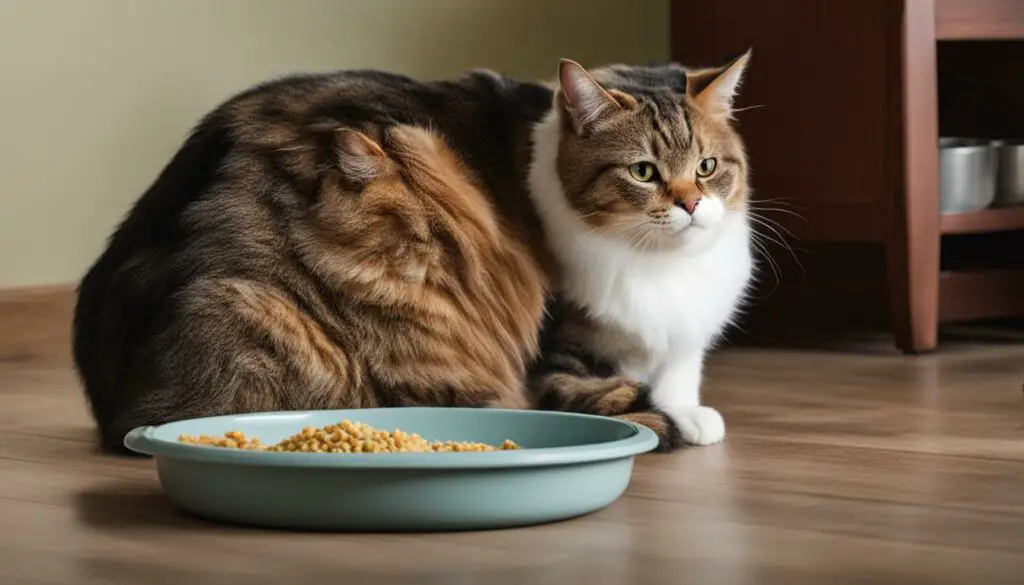
As you navigate the challenges of managing hunger during your cat’s weight loss journey, remember that your veterinarian is your best resource. They can offer guidance, monitor your cat’s progress, and provide personalized recommendations to help your feline friend achieve a healthy weight. With their support, along with your dedication and commitment, you can ensure your cat’s weight loss journey is a successful and positive experience.
Maintaining a Healthy Weight for Life
Now that your cat has reached their ideal weight, the journey doesn’t end there. It’s crucial to continue prioritizing their health and maintaining a healthy weight for life. By following a few simple strategies, you can help your cat maintain their newfound wellness.
First and foremost, it’s essential to continue feeding your cat measured portions based on their ideal weight. This ensures they receive an appropriate amount of calories to maintain their weight. Stick to a consistent feeding schedule and avoid free-feeding, as it can lead to overeating. Consider using puzzle feeders or feeding toys to provide mental stimulation and slow down their eating process.
In addition to portion control, regular exercise is key to maintaining your cat’s weight. Engage in interactive play sessions with your cat using toys like feather wands or laser pointers. This not only helps them burn calories but also provides mental stimulation and strengthens your bond. Aim for at least two play sessions of 10-15 minutes each day.
Monitoring your cat’s weight on a regular basis is crucial to catch any weight fluctuations early on. Weigh your cat every one to two weeks to track their progress. Keep a record of their weight to identify any potential weight gain or loss. If you notice any significant changes, consult with your veterinarian for guidance and support.
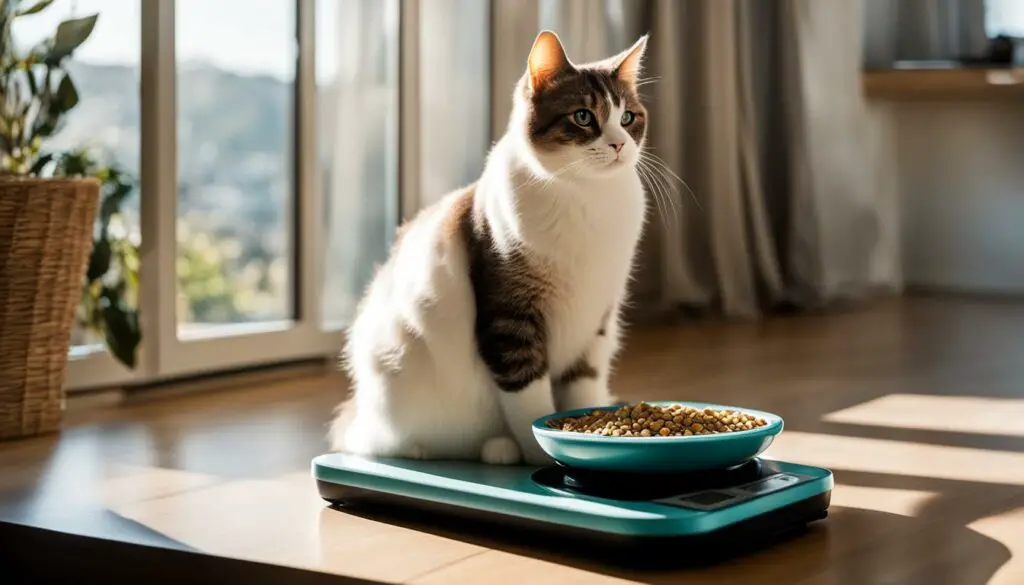
Remember, maintaining a healthy weight is a lifelong commitment. Regular veterinary check-ups are important to ensure your cat’s overall well-being and long-term weight management. Your veterinarian can provide personalized guidance, monitor your cat’s progress, and address any concerns that may arise. By continuing to prioritize nutrition, exercise, and regular veterinary care, you can help your cat live a happy, healthy, and balanced life.
Conclusion
In conclusion, helping your cat lose weight is crucial for their health and longevity. By implementing a weight loss plan that includes proper nutrition, portion control, and regular exercise, you can support your cat in achieving and maintaining a healthy weight.
Consult with your veterinarian for personalized guidance and to monitor your cat’s progress along the weight loss journey. They can provide you with expert advice specific to your cat’s needs and help you create a tailored weight loss plan. Remember to assess your cat’s body condition and determine their ideal weight before starting the weight loss process.
With dedication and patience, you can make a significant positive impact on your cat’s well-being. Prioritize their weight loss journey and be consistent with feeding guidelines, exercise routines, and monitoring their progress. Your cat will thank you with improved health and an enhanced quality of life.
FAQ
How can I tell if my cat needs to lose weight?
You can assess your cat’s body condition by looking for signs like a lack of waist definition, difficulty feeling their ribs, and a droopy belly. If your cat’s body shape indicates they are overweight, consult with a veterinarian to determine their ideal weight and create a weight loss plan.
How many calories should my cat consume for weight loss?
To determine the number of calories your cat should consume for weight loss, first calculate their current caloric intake. Then, reduce the amount by 20 percent or use a formula provided by your veterinarian. Aim for a weekly weight loss of half to two percent of your cat’s body weight, as rapid weight loss can cause fatty liver disease.
What type of food should I choose for my cat’s weight loss?
Select a high-quality cat food specifically designed for weight loss. Look for formulas that are low in calories and fat but still provide essential nutrients. Gradually transition to the new food over one to two weeks to avoid digestive issues.
How should I feed my cat to support weight loss?
Establish a feeding routine and feed measured portions of food based on your cat’s ideal weight. Divide their daily calorie intake into several smaller meals. If you have multiple cats, separate their feeding bowls to prevent competition. Consider using programmable feeders to provide meals at specific times if you’re unable to be present.
How can I encourage my cat to exercise for weight loss?
Incorporate interactive play sessions using toys like feather wands or laser pointers for short bursts of exercise. Aim for five to ten minutes of activity at each session, gradually increasing the duration as your cat becomes more fit. Providing climbing surfaces and rotating toys can help keep your cat engaged and active throughout the day.
What should I use as rewards instead of food treats?
Instead of using food treats as rewards, consider alternative options like playtime or cuddles. This reduces calorie intake while still providing positive reinforcement and bonding opportunities with your cat.
Is there a special weight loss diet available for cats?
Yes, there are specialized weight loss diets available for cats that may be more effective in achieving significant weight loss compared to regular commercial diets. These veterinary weight loss diets are formulated to provide balanced nutrition while helping cats feel full. Consult with your veterinarian to determine the best weight loss diet for your cat’s individual needs.
How do I transition my cat to a new weight loss diet?
Transition to a new weight loss diet gradually over a period of three weeks. Start by offering small amounts of the new food alongside the current food. Slowly increase the ratio of the new food to the old food over time. Enhance the palatability of the diet by adding flavorings or warming the food. Monitor your cat’s acceptance and consult with your veterinarian if there are any concerns.
How do I monitor my cat’s weight loss progress?
Regularly weigh your cat on a scale to track their weight loss progress. Aim to weigh your cat every one to two weeks and adjust their calorie intake as necessary. Keep a record of their weight in a diary or digital tracker.
What should I do if my cat appears hungry during weight loss?
If your cat appears hungry during weight loss, provide distractions like toys and affection to keep them occupied. You can also add water to their food to increase satiety and improve kidney and bladder health. If your cat’s quality of life is negatively affected by the diet, consult with your veterinarian about potential adjustments, such as choosing a higher fiber food.
How do I maintain my cat’s weight after reaching their goal?
Once your cat reaches their ideal weight, continue feeding measured portions and engaging in regular play sessions to keep your cat active. Monitor their weight regularly and consult with your veterinarian for check-ups to ensure long-term weight management and overall well-being.
Source Links
- https://www.dailypaws.com/cats-kittens/cat-nutrition/cat-weight-management/how-to-help-cat-lose-weight
- https://vcacanada.com/know-your-pet/creating-a-weight-reduction-plan-for-cats
- https://askvet.app/how-to-get-a-cat-to-lose-weight/

